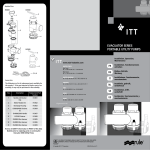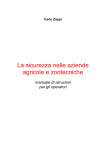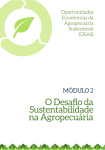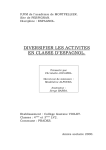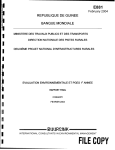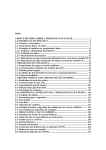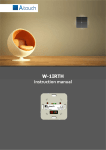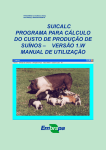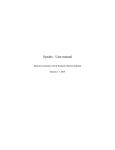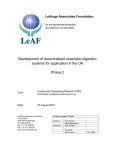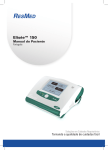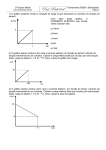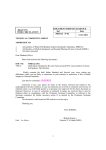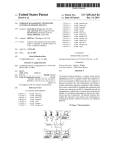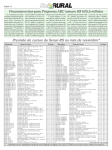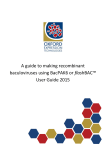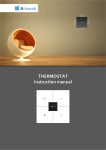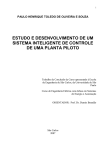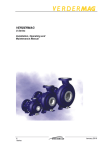Download Biogas Laboratory Setup in Foz do Iguaçu, Brazil
Transcript
Biogas Laboratory Setup in Foz do Iguaçu, Brazil 3rd Progress Report August 2011 Debora Fistarol Lyson Ramón Enguídanos Requena Alexander Bauer Barbara Amon Thomas Amon Content 1 Set-up and beginning of operation of the fermentation laboratory at the Observatory ........ 1 1.1 1.1.1 Considerations about laboratory structure:....................................................................... 3 1.1.2 Considerations about equipment....................................................................................... 3 1.2 2 General overview ......................................................................................................................1 Suggestions from BOKU side to optimize the FPTI laboratory .................................................4 Introduction into fermentation laboratories (second stage) - journal .................................... 1 3 Adjustment of the handbook to the specific needs of the fermentation process in subtropical climates (Task 3.2) .............................................................................................................. 19 4 Overview of the Project Status .............................................................................................. 23 5 Attachments........................................................................................................................... 24 1 1 Set-up and beginning of operation of the fermentation laboratory at the Observatory 1.1 General overview Basic equipment for batch experiments according to VDI 4630 are availed in the laboratory in Foz do Iguaçu. Table 1 shows a list of lab equipments suggested by BOKU, as well as available equipment in the Laboratory in Foz do Iguaçu. All chemicals, needed for the production of the sealing liquid, are available. Table 1: List of required and available laboratory equipment, facilities, measuring instruments, consumption goods Step Lab Equipment Recommended Brand Available in Foz di Iguacu Brand Specifications Cutting Mill Büchi Mixer B-400 No Mixer Cross Beater Mill SK X00 No Homogenizer Standard equipment Yes Cabinet dryer Standard equipment Yes digital temperature control and thermostat of security. Firma Maroni. Muffle furnace Standard equipment Yes Precision of temperature control, configurable microprocessed controller. Firma: QUIMIS. Karl Fischer Titrator Mettler Toledo V20 No Sample preparation: Milling/Mixing Dry matter Organic matter dry Water content Balance Yes Capacity: 120 g. Resolution: 0,0001 g. Firma: MARK 214TH BEL Start of experiment Storage tank inoculum Tank Peristaltic pump Yes Verderflex EV8000 Yes Digital control and frequency changer. Firma: PROVITEC. Balance Standard equipment Yes Capacity: 4200 g. Resolution: 0,001 g. Firma: SHIMADZU 1 pH meter Standard equipment Yes Resolution: 0,001 pH. Precision: +/- 0,005 Firma: TECNOPON Batch experiments Selutec equipment Eudiometer http://www.selutec.de Heating System Yes Own produc tion No Selutec http://www.selutec.de Yes Gas Analyzer Portable gas analyzer Dräger X-am® 7000 No Thermometer Thermometer Standard equipment Yes Digital, precision +/- 1 °C, calibrated. Firma: INCOTERM Barometer Barometer Standard equipment Yes Resolution: 0,1 hPa. Precision: +/- 3 hPa. Firma: TESTO. The laboratory includes the main equipment required for performing the batch tests (e.g. cabinet dryer, muffle and eudiometer set: images 1, 2 and 3). Parts of the equipment arrived during the training, such as the heating system for the fermenter and one balance. The gas analyzer “Dräger for reading the biogas composition was one of the most important equipment, not available during the training. During the first test, the composition of the gas was not measured. Materials, such as the components of the confined liquids and the digital thermometer (with a decimal place) are still to arrive. Image 1: Cabinet dryer Image 2: Muffle Image 3: Eudiometer In general terms, the available equipment allows the start of a first experiment to check the quality and the characteristics of the equipment, but the manufacturer gives none guarantee for their accuracy. For this purpose, cellulose from the BOKU, as well as cellulose from Brazil and sugar will be used. The numbers of eudiometer systems allow an analysis of one sample. 3 of 12 digester have to 2 be used for the inoculum and 6 of 12 for the internal standards (cellulose and sugar). Experiments with more than one sample are not feasible at the moment. 1.1.1 Considerations about laboratory structure: Gas exhaust system: the cabinet dryer and the muffle have no gas exhaust system. The laboratory will change its location to a new construction in October 2011. Due to this reason there was no need for great investments in the structure of the actual laboratory room, although a gas exhaust system will be installed in the new room. Our recommendation was to build a gas exhaust system in any case, since inhaling gas emission from the cabinet dryer and muffle is dangerous to the health of the laboratory workers. Air temperature: the room temperature was not controlled. A room thermometer was not available and the existing heating system in the room was not used (Image 4). The room is not accurately closed; there is a permanent exchange between the outside and inside air by means of two ventilators on the wall (Image 5). Doe to great differences in temperature during the day (middle min. 9 °C and middle max. 23 °C in winter) the quality of the results will be influenced negatively. Recommendations to the new laboratory: 1) A control to maintain the air temperature without major oscillation. Therefore, it is necessary that the walls are duly isolated, a heating and air conditioning system will be installed; 2) Air circulation should be avoided as it may modify the temperature of the substrates and, thus, influence the results. Image 4: air conditioning Image 5: ventilator on the wall 1.1.2 Considerations about equipment All available equipment is listed in table 1. Some equipment arrived during the training, others are still not available. FPTI has ordered an optional Eudiometer system at Selutec, which has still not arrived. This system needs to be calibrated. The Eudiometer set is composed of 12 units allowing an analysis of 1x inoculum, 2 internal standards (cellulose and sugar) as well as of 1 additional sample. Fermenter heating system: the heating system is part of the eudiometer apparatus from Selutec. This equipment was still not available. Due to this reason an optional heating system towards the own Eudiometer set was required (Images 6 and 7). Unfortunately, the FPTI colleagues decided to order 12 magnet stirrer and heating plate equipment, without consulting us. This equipment is not ideal for this purpose, since 1) it does not resist a constant use; 2) does not allow an exact temperature control that is required for the present tests (Image 8); 3) there is no thermostat connected to 3 switch the equipment on and off according to the required temperature. But we made a test when the ordered equipment arrived. One of them was available. Prior to the training, the colleagues from FPTI laboratory performed a test with the equipment, nevertheless an exact temperature control was not considered to be necessary. Image 6: heating system Image 7: fermenter on top of the heating system Image 8: heating system control Thermometer (for substrate): there are 2 types of thermometers, one is digital and the other is a mercury thermometer. The digital thermometer does not possess a decimal place. Our recommendation was to presently use a mercury thermometer, since it allows a more accurate temperature indication, as it is required; nevertheless it is not a perfect solution. A digital thermometer with one decimal place was ordered but it was not still available. 1.2 Suggestions from BOKU side to optimize the FPTI laboratory Table 3 shows all suggestions from the BOKU in the time of the training in order to improve the laboratory work and to ensure optimum results of the biogas experiments. Table 3: Previous situation of FPTI laboratory and proposed solutions Inoculum preparation Situation: The inoculum gathered prior to the training, cannot be used for the test. Problems: 1) The inoculum was collected at the prefermenter from a biogas plant, which has a high level of organic material and thus a high microbial activity. These characteristics are not intended for the inoculum, since an excessive microbial activity disguises the fermentation result of the substrate to be tested. Suggestions: 1) The inoculum sample must be taken directly to the main digester, because in this place the bacteria activity is smaller than in pre-fermenter. 2) During the period the inoculum was kept in the cabinet dryer it concentrated dry matter. The container of the inoculum was stored and had a cover with a diameter of 25cm that remained 2) The inoculum must be stored in a recipient with a small cover that is not too tight. Thus, the gas may flow and the water will be lost only in a small quantity. The inoculum must be free of visible solid 4 partially open as to prevent a concentration of material. gas. This led to an excessive loss of water. Possible causes: A) The original substrate contained too much dry matter content; B) It was stored in a recipient with a large cover. In order to avoid gas pressure it was partly opened and lost too much water as well. 3) The biogas plants do not have a heating 3) A solution needs to be discussed at BOKU. system. Due to this reason, the bacteria are not adapted at a constant temperature of 37,5°C and the inoculum cannot be used for laboratory experiments. This occurs mainly in winters. Temperature of fermenters Situation: FPTI laboratory has bought 12 magnet stirrer and heating plate equipment for the batch experiments. This equipment was suggested by BOKU. The reason for this decision was to be an option to the Selutec Eudiometer set, mainly due to the homogenisation possibility of the substrate. The equipment was tested and it appeared not to be adequate for the experiments. Problem: Suggestions: 1) The temperature scale is shown on a scale 1) Installation of a water bath with a heating system from 0 to 10, and so it is very difficult to define and a thermostat the ideal range for the experiment (37,5°C ± 0,5°C) 2) The equipment has no thermostat, i.e., it is 2) see point 1 not possible to control the temperature escalation of the fermenter. Dry matter and volatile solids content analysis Situation: There was no gas exhaust to the muffle and cabinet dryer. The laboratory will change its location in October, thus a high investment on the structure of the laboratory was not necessary. Problem: Suggestion: 1) situation is not adequate for the laboratory 1) In any case, the installation of a gas exhausts system. worker Laboratory organization Situation: The worker’s concentration is often disturbed, e.g. through unexpected visits, unexpected work orders, constant calls. Problem: Suggestions: 1) It could cause a distraction during an analyze 5 lecture. The laboratory’s work claims a high 1) Any visit should be scheduled; concentration level and continuity. Interferences 2) The tasks assigned shall comply with a priority and are not recommended. it is necessary to draw the attention of their supervisors to the consequences that an assigned task in a certain moment may harm the analyses and the reliability of the laboratory; 3) Phone calls need also comply with a priority and must not interfere with the course of the analysis. 6 2 Introduction into fermentation laboratories (second stage) - journal The introduction into the fermentation laboratory (second stage) takes the operational process under subtropical climate in Foz do Iguaçu into consideration. This activity was supported by Debora Fistarol Lyson and Ramón Enguídanos Requena during a period of three and five weeks respectively. The training in the fermentation laboratory processes started on July 5th, 2011. The program of the second stage is shown in Table 2. Table 2: Training (second stage) in the fermentation laboratory processes Week 1 Activities Tuesday 05.07. Equipment and laboratory structure revision On the first day of the training a control of the available equipment in the laboratory FPTI was done. A detailed report about the considerations and suggestions respect structure and equipment is on point 1: Set-up and beginning of operation of the fermentation laboratory at the Observatory. Inoculum evaluation The available inoculum was checked about the conditions of capture and storage. It was decided to bring a new substrate on Tuesday. Table 3 shows the suggestions from the BOKU about inoculum to collect and storage. Week schedule Wednesd ay 06.07 Presentation A presentation of the EU-AGROBIOGAS website and the general applications by FPTI laboratory took place. This calculation tool was developed by KTBL and optimized during the European Project EU-AGROBIOGAS coordinated by BOKU between 2007 and 2010. A data base was made available including the results of the 12 project partners. The tool allows estimations for the methane production of different materials, as well as for the costs and the final revenue. This presentation included the password to allow FPTI laboratory the access to the home page. This calculation may serve as a basis for the comparison of the evaluation of the results. Finding options regarding the heating of the inoculum outside the dryer There was a need to find options for the heating and to keep the inoculum’s temperature during the test set up. One available apparatus was equipped with a container for heated water at a temperature controlled by a connected thermostat. The test consisted in transferring the heated water through the hose to a larger container (images 9 and 10). Subsequently, the inoculum was positioned directly in the container. This system allows the heated inoculum to be kept at the required temperature even while the fermenters are filled. Image 9: inoculum heating system Image 10: inoculum heating system Another possibility to store the inoculum is an equipment for bacterial culture (Image 11) 1 allowing the storage of up to 3 containers (5 liters) of inoculum with a controlled temperature. Image 11: bacterial culture equipment Revision of the manual and adjustments: 1st part (see table 4) Thursday 07.07. Visit to the Condominio de Agroenergia da Micro Bacia do Rio Ajuricaba (Agroenergy condominium of the Ajuricaba river micro basin), a Pilot Project coordinated by Itaipu (images 12 and 13). Image 12: Project plaque Image 13: Information project plaque This project involves 34 small and middle livestock farmers; each of those has a small biogas plant. A total of 1072 cattle and 3082 pigs produce the organic material for the anaerobic digestion. The expected annual production consists in 16 thousand m³ (manure), 267 thousand m³ (biogas), and 445 thousand kWh electrical energy. All farmers are connected to one central power generator and send their own energy to this central. This project comprises a total of 25 km ducts to transport the biogas. We visited 2 farmers, one pig and one cattle owner. Both had very good experiences. We were told that they invested in the animal installations but the biogas plant and biogas ducts were financed by the project. Description of the biogas plant at the pig owner: This property has an average of 700 farrows. One biogas plant follows the Canadian model with a rectangular storage tank for waste that is covered by a gas collecting canvas (image 14) and a secondary storage tank for depositing already fermented organic material (image 15). The substrate to be fermented is pumped every third day to the fermenter. A mixture of the substrate in the fermenter is made once a day by pumping during a period of approximately 2 hours. The produced biogas is liberated from moisture and solid particles using purifiers installed in the same property (image 16). Having concluded this purification, the biogas is led by means of an underground conduit to an electric energy producing central. 2 Image 14: Fermenter and gas collector Image 15: Secondary storage tank Image 16: Purifier for moisture and solid particles Description of the biogas plant at the cattle farmer: The following property we visited is destined for beef cattle farming. It is a small producer with approximately 20 animals. The biogas plant model was developed in this region and offers a sump (image 17), a fermenter (image 18), a gas collector and a storage tank for depositing fermented material. The solid particles and the straw are separated from the substrate in the sump before entering the fermenter. The fermenter consists in two containers, as illustrated in fig. 5. One of them is subterranean and is located under the superficial fermenter. After the fermentation process the substrate is thrown into the lagoon that deposits the fermented material. The fermented material is led periodically to the field which then acts as a biofertilizer. Similar to the previous property the generated biogas is purified with regards to solid particles and moisture before it is sent to the central that produces electric energy and which is located outside the property. Image 17: sump Image 18: fermenter The biogas produced in the 34 properties included in the project, is sent to the thermoelectric plant, then it is purified and transformed into electric energy via a generator of 100 kVA (=100kW) (image 19). 3 Image 19: Electric generator The thermoelectric plant consists in complementary projects. A grain dryer was set up near the central energy generator (image 20) aiming at drying the cereal production of producers who participate in the project. This implies an economic benefit of up to 30% of the grain’s value. It is a circular dryer with an approximate diameter of 6 meters and a bottom part with orifices allowing a passage of heated air. The air is heated by two types of renewable energy in systems that are still under development. One of them is the combustion of biogas in a furnace that heats up the air that is conducted to the dryer (image 21). The other one is made via a solar heating system that stores the heat by means of a plastic canvas leading the heated air in a tubular form to the dryer (image 22). Image 20: Grain dryer Image 21: Furnace for combustion of biogas Image 22: solar heating In both properties we visited, a collection of inoculum was realized. At the outlet of the fermenter on the pig farm property were gathered about 5 litres of material. On the cattle farm we gathered the same quantity of material from the secondary storage tank. The aim of this collection in different locations was the characterization of the substrate by defining the dry matter, volatile solids, and the bacteria’s activity. In both cases eudiometers were used. The biogas plants we visited function at room temperature. Thus, the inoculum was transported to the laboratory at room temperature. In the laboratory the material was tested at 37,5°C regarding its acclimatization until the beginning of the experiment. Friday 08.07. Start of dry matter determination Before the dry matter and the solid volatiles were determined, it was detected that the available crucibles were too small to determine the dry mass of a substrate with a high water level. In order to prevent a waste of time, we started testing the dry matter in two phases, i.e. 4 using 105°C beaker containers for the dry matter analysis. The container was weighed, and then an approximate portion of 130 gram were weighed and taken to the dryer. It remained in the dryer until the weight of the substrate remained constant. The result was achieved the following Monday. On the other hand, there was a necessity to get crucibles with adequate dimensions from a laboratory of the UNILA. This material will be available next week. Manual revision and adjustments: 2nd part (see table 4) Week 2 Activities Monday, Magnet stirrer and heating plate equipment installation; temperature test 11.07. The 12 ordered apparatus arrived on Friday. On Monday they were tested. They were all connected to the network. An expert supported this process as to ensure that the energy supply is not jeopardized by the required electric power system. All apparatus were connected at the temperature in phase 2 and a simulation was performed by heating the fermenter filled with water within a larger container with water as to allow a control of the internal temperature of the fermenter. The test was performed during the day and the temperature changes were controlled hourly. The adjustment was on an individual level, since all of them presented different temperatures and some exceeded 40°C on the lowest adjustable level: 1. the temperature of some fermenters was adjusted to the required value of 37,5°C until late afternoon. The following day a different value should be noticed. Preparation of UNILA ‘s crucibles Crucibles of an adequate size were provided by UNILA as a loan. They were prepared and stayed in the muffle for 6 hours at a temperature of 1100°C. Meeting There was a meeting with the new FPTI-CEB* head Ansberto do Passo Neto and Caroliny Matinc, Eliza B. Freiberger, Ramón Enguidanos and Debora Lyson. Mr. Passo Neto introduced himself in this meeting as head of the CEB-Centro de Estudos de Biogás do FPTI*. This study group was created approximately 6 months ago and its objective is to concentrate on the research and development of the biogas production. Mr. Passo Neto explained that the CEB is divided into three different areas, such as: 1) development of biogas production with regional agricultural producers, taking the micro-basin project of the Ajuricaba river as an example. 2) Development of the FPTI laboratory project. 3) Development of the biogas plant pilot project within the Itaipu Dam as to use human dejections, rests from restaurants, as well as weeding rests from the mill area. From our point of view, all items regarding the necessity to maintain a constant room temperature and the gas exhausts of the dryer and the muffle were clarified. Mr. Passo Neto is currently the contact person instead of Mr. Trindade. (*FPTI-CEB: Center of Biogas Study of FPTI) Sealing liquid preparation and storage of inoculum from Embrapa The confined liquid used in the eudiometers was prepared in a limited portion with regards to the available reagents and according to the manual. Storage of inoculum from Embrapa The colleague Mr. Ricardo Steinmetz from EMBRAPA came to FPTI to participate in the training by cooperating mainly in the calibration of the eudiometers, providing the inoculum, and supporting the adjustments in the manual. The inoculum he brought was stored at a temperature of 37,5°C. Week schedule Tuesday Presentation to FPTI personal 5 12.07 Optimization of biogas production resulting from maize, sorghum and rye under dry climatic conditions (image 23). Mr. Cicero Bley, Mr. Marcelo Alves de Souza, and about 15 participants from FPTI and the Federal Technological University of Paraná (UTFPR), a Brazilian company of agricultural research (EMBRAPA), Regional Development Agency of West Coast of Paraná (ADEOP), incubated companies, International Hydroinformatics Center (CIH), Center of Biogas Study (CEB) and Itaipu Consulting for renewable energies. The presentation was very well accepted and took 1,5hours until the end of discussion. Image 23: Presentation Start of volatile solids determination The dry matter was weighed. By using the crucibles previously prepared during 5 hours at 550°C, first the tare was weighed, and then the dry matter of approximately 2kg. The material was directed to the muffle as to slowly achieve a temperature of 550°C (in 2 hours 250°C and in the next hour 550°C) and remains 3 hours in this temperature. Magnet stirrer and heating plate equipment End of temperature testing and organisation of a new heating system for the fermenters. The temperature of the fermenters that were stable the previous day, had a temperature of 40°C today, which is the minimum possible temperature for this equipment. Due to this reason it is not possible to use this system. A new heating system was provided, in which small heating systems connected to a thermostat will maintain the temperature at a required level. End of volatile solids determination Wednesd Calculation demonstration: volatile solids ay Based on the table developed at BOKU Laboratory 10 years ago, the required calculations to 13.07. determine the dry matter and the solid volatiles were shown. An additional table developed at FPTI laboratory was used as well to present the results. Data analysis The criteria to evaluate statistically the results were shown to allow a decision whether a repetition of the test is necessary or not. The results of the analysis performed, exceed the required limit and need therefore to be repeated. The reason is based on the material’s heterogeneity making the ideal mixture difficult. Hand book revision and adjustments: 3rd part (see table 4) With the participation of Ricardo Steinmetz of EMBRAPA. Thursday Preparation of the fermenters to the new heating system All 12 fermenters were mounted on the same side of the bench. Two glass containers to 6 14.07 store water were ordered. One of them arrived and the test started with the magnet stirrer and heating plate equipment. A higher water level could control the temperature while using 3 heating systems for a container with 6 fermenters. Calibration of the eudiometers and filling the columns with sealing liquid Mr. Steinmetz from EMBRAPA, who performed the calibration of the eudiometers, asserted that the equipment purchased by FPTI provides a millimetric metering within the acceptable patterns allowing reliable results. Filling the columns with sealing liquid Another step within the preparation to the fermenter’s tests was the filling of the eudiometer columns with the confined liquid. Testing the inside pressure of the eudiometer and calculation of the corrector factor According to the VDI 4630, the results from the produced biogas volume need to be without pressure which results from moisture. To obtain this result, a correction in the metering is required. This correction is performed by a metering in four levels of different internal pressures, and using Excel, a diagram is to be elaborated including a linear regression line. The formula obtained by this line indicates the correction factor. Friday 15.07 Visit to the Colombari farm (swine breeding and biogas plant) Mr. Colombari possesses 3000 to 5000 animals (pigs). Pig-farming produces a total of 1200 m³ liquid manure per day (Images 24 and 25). Image 24: Pig-farming Colombari Image 25: Pig-farming Colombari The biogas plant following the Canadian model possesses 2 fermenters, both with a gas tank, a secondary lagoon (storage place) (Fig. 26, 27 and 28). The retention time amounts to 32 days. After the expiration of this time, the liquid manure of the biogas is transferred to the storage places and carried regularly to the fields. There are no data regarding the content of the substrate (neither input nor output). Once a year, the soil and water are subject to control. 7 Image 26: Mr. Colombari and Ms. Matinc (FPTI) in front of the main fermenter Image 27: second level fermenter Image 28: Storage tank (secondary storage tank) For safety reasons he uses two compressors (image 29), one of the compressors pushes the biogas to the motor and the other towards the combustion of the additional biogas (image 30). Image 29: Compressors Image 30: Protection The reactor has 100kWh, produces 75 kWh, and is served by 50m³biogas/h. Mr. Colombari is willing to optimise his system as to produce up to 300 kWh, the maximum permitted by law. From our point of view, the difficulties are: o Lack of temperature control in the system. There is no heating in winter, thus a reduced production is recorded during this season (image 27). In summer it produces too much biogas and has therefore to combust gas on a regular basis. o Lacking efficiency of the substrate mixing system. The blend is conducted via a pump and a tube with a diameter of 10cm. The bottom of the fermenter needs to be regularly (every two years) cleaned, since it accumulates a layer of solid material. o Loud noise from the power house which is located near the household and the animal husbandry. o Lacking professional support to optimise the process. 8 Sampling of inoculum for experiments Inoculums were gathered in 2 different outlets of the biogas plant as to characterise the substrate. One of the outlets is located after the main fermenter (image 31) and the other after the secondary fermenter. Image 31: Outlet after the main fermenter Dry matter content determination: new substrate and repetition of first analysis The new inoculum will be tested and previous analysis will be repeated. Week 3 Activities Monday, 18.07. Meeting with Ms. Matinc and Ms. Freiberger: general laboratory use and organisation and quality management We noticed that in the past two weeks the work of two colleagues from FPTI laboratory was often interrupted due to different reasons, such as unexpected visits, tasks assigned, and constant telephone calls. We explained the necessity to work without interruptions in the laboratory as to obtain reliable results in the analysis. We proposed that 1) any visit should be scheduled, 2) the tasks assigned shall comply with a priority and it is necessary to draw the attention of their supervisors to the consequences that an assigned task in a certain moment may harm the analyses and the reliability of the laboratory, 3) phone calls need also comply with a priority and must not interfere with the course of the analysis. Calculation demonstration: BOKU chart – general A general statement on the BOKU chart was given, which needs to be filled in and the data are repeated automatically, an automation of the analysis quality control. Calculation demonstration: methane efficiency A profitability analysis regarding the methane conversion including results on BOKU’s elementary analysis was made. Demonstration and praxis of silage in laboratory for experiments with energy crops The cut of grass in the Itaipu area was brought to the lab for silage. The material was pressed in a 2 liter container, sealed and stored in the refrigerator. The time for finalising the silage process will take 2 months. Sample preparation of fresh mass in the vacuum equipment The same material was prepared in vacuo to observe the results. The results of the conservation will be visible within 2 months. Volatile solids determination as described above. Out of the tested inoculums, the material coming from the Colombari farm provided the high test dry matter content and volatile solids: 2,88%DM and 1,66%VS. Tuesday Calculation demonstration: specific methane production The calculation of the specific methan production was demonstrated by using the volatile 9 19.07 solids values. Fermentation test with the different substrate to inoculum The 4 different inoculums were placed into the eudiometer for fermentation with the aim to observe the gas production. Out of the 4 tested inoculums, the the level of gas production of the Colombari inoculum was similar to the levels of gas production of inoculums used at the BOKU. Therefore, we decided to use this inoculum in the Batch test. Sealing test: change of 2 columns In parallel, the gas tightnesssistem was tested by using nitrogenic gas. 2 measuring tubes showed gas leakage due to a production fault. One of them could be changed against a tube of BOKU. With a total of 11 devices, one of the testes was reallised with only 2 repetitions Gas exhaust at muffle and cabinet dryer was installed A team of 2 technicians installed the system which was needed for the gas exhaust of the drying in the cabinet dryer and the muffle. Image32: Muffle Wednesd ay 20.07. Image 33: Cabinet dryer Calculation demonstration: Buswell formula The use of Buswell’s formula was demonstrated according to the VDI standards. Analyze of data dry matter content and volatile solids determination as demonstrated before Data demonstration form A model for a laboratory report was presented based on a BOKU report. The colleagues may use it as a template to develop their own model. Preparation of the second water container After receiving the 2nd water container, we were able to finalize the preparation of the experiment start. Temperatures between 36.5°C and 38.5°C have been measured. This means an oscillation above the expected values according to the manual but still within the limits suggested by VDI (±2°C). The strict criteria described in the manual are coming from actual results of European institutions. The new heating system with sensor and thermostat was not yet available. Therefore, the fermentation test was started with the actual heating system. 10 Image 34: 2 Eudiomether sets Eudiometer onside pressure: A test conducted to measure the internal pressure of the tube which replaced the dammed one. Calculation Based on the amount of volatile solids, the amount of material which was necessary for the fermentation test was calculated. Start of the first experiment. The measuring tubes have been prepared and properly closed in order to avoid the exhaust of gas. The water temperature of the container was controlled accordingly. The substrates have been weighted directly in the fermenters. The fermenters have been filled up with app. 200 g inoculum and the values were recorded. After a short homogenization process the fermenters have been connected to the measuring tubes. The measuring tubes were fixed to the fermenter with a metal clip. After the installation of the fermenters, the system was filled up with nitrogen in order to certify the tight and approved. The fermentation test was now ready to start Image 35: Experiment monitoring Thursday Meeting with FPTI, EMBRAPA and BOKU members to discuss new projects 11 21.07 The meeting started with an introduction by Mr. Bley who explained the general objectives of the installation of the biodigestors in the Parana basin 3 region. The manure management of the animal production is an urgent matter to be improved, basically to minimize the environmental impact. Biogas production is considered primarily as a valid method to tread those organic residues. He also pointed out the existing political decision to support biogas as renewable energy source and explained that other Brazilian institutions potentially will adopt the biogas research laboratory according to the BOKU model. Even other countries in Latin America show strong interest to the presented solution, as for example Chile. Mr. Bley furthermore explained the PTI’s idea to set up a SOP - like list of standardized information on how to build up and to manage a high quality biogas research laboratory. This list shall function as a template to be distributed to other interested institutions. Mr. Passo Neto explained the different areas, where the potential of biogas production in the regions is seen. These are as follows: Industrial area: • poultry slaughter • Cassava manufactory • UPL (unities of piglets production) • Vinasse (not relevant for the region) Rural area: • pig and cattle manure • Possibly poultry manure • Energy crops, mais silage, oats, grass Urban area • domestic residuos • residuos of restaurants • PTI pilot project Later on, the BOKU view was presented by Mrs. Lyson. The different research areas, suggested by Prof. Amon have been presented. A Joint Advanced Research Program (FPTI_BOKU) has been discussed extensively beforehand between Prof. Amon and Mr. Cicerlo Bley. During the meeting on 21st of July, the content has been adapted in the following way: Suggestions for cooperation and further joint research projects: 1) “residual gas potential of digestate from existing biogas plants in Brazil: animal manures, winter-summer comparison, cattle, swine and poultry”. Remarks: The management of the poultry manure has no high priority, as the treatment of solid manure is essentially resolved. Following projects should priority to pig and cattle manure. It would be an interesting task to conduct an analyze of the biogas potential for the winter months. There is no internal heating system within the fermenters which consequently leads to a strong decrease of biogas production. To conduct a calculation of investment costs for a heating system and to check the economic viability is strongly recommended. Another problem occurs during the summer months: The biogas production is considerably higher than the storage capacity. Therefore there is a strong need to optimize the construction plan of the biogas plants. Other needs to be mentioned are as follows: • To make better use of the heat • To optimise the biogas quality • To optimize the fermentation conditions (temperature, frequency of feeding, homogenization of the substrates) 2) Determination of the biogas potential of urban residues, food residues and rests of 12 grass cut Remarks: The potential of biogas production of these kinds of materials has a strong priority in comparison to cofermentation from animal manure and energy crops. This is because of the local and regional available substrates, as well as due to the fact that FPTI currently sets up a pilot plant which will work with the mentioned raw materials. A new research project is urgently needed to support the pilot project. 3) Determination of the biogas potential from energy crops Remarks: This research project would aim at giving an alternative to producers to make better user of the soil in the winter months and, thus, to rise the economic income of the producer Together, the three projects should deliver sufficient data to set up a Brazilian biomass database in the area of biogas production. At the end of the meeting it was suggested to write a letter of intent for a new agreement between ONUDI, EMBRAPA, FPTI, ITAIPU and BOKU Image 36: Meeting participants from left to right: Airton Kunz (EMBRAPA), Debora Lyson (BOKU), Ricardo Steinmetz (EMBRAPA), Eliza Freiberger (FPTI), Cicero Bley (back) (FPTI), Caroliny Matinc (in front) (FPTI), Ansberto do Passo Neto (FPTI), Marcelo A. de Souza (FPTI), Ramón Enguídanos (BOKU) Week 4 Activities Monday 25.07. Monitoring test Reading off daily gas production. Water level and temperature control. Importance of controlling these parameters on Fridays and Mondays, before and after the weekend. Not significant evaporation in both pools. Monitoring temperature Different temperature between pools ± 2°C (36°C - 38°C). All heaters do not work in an homogeneous way and is impossible to have an accurate temperature control in both pools Previously to the start of the test, it was necessary to translate all excel files into 13 Tuesday 26.07 portuguese language and reinsert links and formulas. During the process, some formulas were not properly inserted into the new excel file „analysis table“. Consequently, the calculated amount of substrate to be fed into the fermenter for the test was wrong. Together with the fact of significant difference in temperature between both pools, decision to stop the test was taken. Decision to cancel the test Visit to Colombari biodigestor Visit to Colombari biodigestor to collect more inoculum (pig manure seeding). Taking samples from exit biodigestor I and exit biodigestor II in order to compare results between them and previously collected samples, regarding dry matter, volatile solids analysis and activity test. Arrival to the laboratory. Storing the material at 37,5°C. Testing peristaltic pump Pump provided with electronic device to control rotation speed and time. Checking different values in order to optimize the required amount of inoculum to be filled into the fermenter (200 g), with the most accuracy possible. Explaining how to organise the equipment before start filling, showing how to fill the inoculum into the fermenter and how to connect the pipe into the storage tank to obtain a homogeneous and representative sample. Pump works properly (Image 37). Image 37: Test with the peristaltic pump Wednesd ay 27.07. Image 38: crucibles Preparation of material for analysis First preparation of material for analysis (crucibles). Numbering every cup for its subsequent identification (image 38) and putting into the muffle for 6 hours at 1100°C. Dry matter analysis To determine properties of Inoculum. Put into the oven 3 replicates from each material. Warm up to 60°C for 6 hours and then, up to 105°C for the whole night. Creating files in Excel and Word document to print and collect data (gas measurement, gas analysis, temperature control, etc.). Working with Eliza and Caroliny on excel files Explaining the aim of each file, links between them, describing which data has to be manually inserted by them and which is automatically calculated by Excel. Looking through calculations and formulas. Listing, step by step, how to put the data in, and order to follow for every stage of the experiment (DM and VS analysis, ratio and amount of substrate calculations, gas measurements, etc...) Thermostats received Installing the system (heater, sensor, and thermostat) together with an electrician from PTI. System was composed of heater and sensor connected to the thermostat. Programming thermostats at 37,5º C with a variation range ±0,4. (images 39 and 40) 14 Image 39: heat system Image 40: heat system and fermenters Testing the system Installing water stirrers in both pools. Heating system works properly without significant temperature variations between fermenters. Thursday 28.07 Friday 29.07 Dry matter Putting the samples from the oven into dessicator for one hour. Measuring output weight and write it down in the table. Volatile Solids analysis Putting the sample into the muffle. Increasing temperature from environmental temperature up to 250°C gradually in 3 hours. Then, increasing immediately up to 550°C and maintining it for 4-5 hours. Let the muffle turned on at 105°C along the night, due to high humidity and not having enough time to measure output weight. Start monitoring the temperature in the laboratory Using thermometer provided with maximum and minimum, to know how much degrees decrease during the night. At the moment is winter in Brazil, and the temperature decrease significantly. Testing Dräger equipment The one from PTI is borrowed from a professor. Checking different options and testing with the gas test, is found out is not calibrated. The composition of test gas at laboratory is 70% CH4 and 30% CO2. Suggestion to order a test gas a with a standard composition: 50% CH4, 40% CO2, 10% N2. Whole Dräger equipment Whole new Dräger equipment is expected to come in September. Volatile solids analysis Putting the samples from the muffle into the dessicator for one hour. Measuring output weight and write it down in the table. Checking if difference between replicates is lower than +/- 2%, so we can accept the method. Results from VS analysis put into the excel file „Mixture of Samples“ to obtain the amounts of substrate for the Batch test. DM and VS analysis results from the substrates were obtained previously. Testing magnet stirrers inside the fermenter filled in with inoculum. Stirring system is integrated in the heater, although is independent and is provided with a speed control. At the minimum speed, the rotation speed is not equal in every system, so we decide to use just six working properly and stir alternately the four units. Proposal to buy some kind of plastic material in order to put the magnet stirrer into a piece of plastic as we have at BOKU, to obtain a better mixing. Laboratory temperature during the day ranges between 22°C-24°C. During the night decrease to 18°C-19°C. We order a climate 15 Week 5 control unit with thermostat to start test on Monday. Activities Monday, 01.08. Talk with Alexander and Debora discussion about calculation, ratio inoculum/substrate and questions about materials Talk with Eliza and Caroliny about the importance of being methodical and concentrate during the start, clarifying steps to follow and everyone’s task Turning on equipment, warming up water Start with the experiment Printing the file with the calculated amount of substrates (Cellulose BOKU, Cellulose PTI, Sugar). Filling in the substrate and writting down the real amount. Same filling system as BOKU: storage tank with controlled temperature of the inocullum at 37,5°C. Mixer in it, running while filling in the fermenters. Pipe in the storage tank is located at the middle level of the tank to obtain a representative sample. Pipe is connected through the peristaltic pump with another pipe to fill in the fermenters. Accurate weights obtained. Taking three samples from the inoculum at three different times for its dry matter analysis to check homogeneity of inoculum in all units. Image 41: Substrate weighting Image 42: Tightness test with N2 Tightness test with N2 Initial value and first reading Tuesday 02.08. Eliza and Caroliny monitoring the experiment Water and temperature control. Gas production reading. Collection of the data and input into the excel file. View of the Experiment. 16 Image 43: view of the experiment Wednesd ay 03.08. Thursday 04.08. Stirring each fermenter for half an hour, mixing every unit at the same time. Decision to mix every unit once per day in the morning after reading. Checking how the system works. Working on excel files Identification of mistakes on the tables and graphics due to leaks, temperature variation, etc. Interpretation of graphics and results. Explanation of different therms such as specific methane yield, specific biogas yield, specific biogas production of sample material, and where are they located in the Excel file. Review of process to calculate the pressure correction factor, cell location in Excel file, and influence in the results. Visit from a TV program to record the laboratory and talk about the projects carried out at PTI and BOKU. Control and monitoring the experiment. Eliza and Caroliny monitoring the experiment. Water and temperature control. Reading off daily gas production. Collection of data and input into the Excel file. Working on the manual. Writing the procedure of dry matter and volatile solids analysis. Recommendations from Ricardo (Embrapa) ) about analysis experience in Brazil were taken into account. Two specific procedures were written depending on the type of material, liquids or solids. Installing a drop box in the laboratory Computer. Explanation of how to use it to share data and results with BOKU. Caroliny explains the idea to create a software at PTI to build a Database involving different biogas laboratories in Brazil and Latin America. Possibility to discuss with BOKU about experiences in Europe. Checking with Eliza list of equipment already ordered. Suggestion to order more equipment, such as: specific laboratory tweezers, laboratory spoons, funnels of different sizes, gardening scissors. Control and monitoring the experiment. Reading off daily gas production. Collection of data and input into the excel file. Monitoring room temperature and stirring fermenters Visit from an investment institution interested in Biogas research. Climate control unit (image 44) The goal is to heat the room, approximate temperature control during the night and maintain it constant during the day. Checking parameters to adjust an optimum 17 temperature. Freiday 05.08. Image 44: Climate control unit Get in touch with the oven and muffle manufacturer in order to get a gas collector connected to outside to avoid presence of toxic gases in the labor. Possibility to order a new muffle with programming device. Explanation about when to stop the experiment. Daily production may be lower than 1% of total production. Showing where can also be checked on the excel file. Control and monitoring the experiment. Reading off daily gas production. Collection of data and input into the excel file. Week 6 Stirring fermenters. Fermenter 2-2 and 2-3, both filled with cellulose PTI, broke while stirring. Glass shows to be really thin and fragile. Decision to stop stirring fermenters with current system. Both fermenters belong to the same unit, therefore, we cannot accept the results from only one fermenter. Cellulose PTI rejected. Monitoring room temperature. Climate control unit broke down during the night. Order to buy two electrical heaters. Room temperature difference ranges between 20°C at 08:00 and 24°C at 18:00. Activities Monday 08.08. Control and monitoring the experiment. Reading off daily gas production. Collection of data and input into the excel file. Tuesday 09.08 Monitoring room temperature. Turning on electrical heaters. Testing different parameters to adjust the room temperature at 26°C. Isolation of laboratory. Laboratory room completely separate from the offices. Initially, the laboratory and offices were separated by a wall, closing half of the height of the room. Now, the wall rise up to the roof. Ventilator exit was sealed up. Meeting with a climate control company. Description of laboratory requirements concerning temperature. Development of a project to isolate completely and control temperature conditions. Meeting with Ansberto, Caroliny and Eliza to discuss about which analysis can be carried out by PTI, and which can be order to external laboratories, like EMBRAPA, or the department of chemistry from University UNILA, attached to ITAIPU. Control and monitoring the experiment. Reading off daily gas production. Collection of data and input into the excel file. Monitoring room temperature. Review of formulas and calculations for DM and VS analysis. Review of tables. Dräger. Explaining how to use the gas analyzer, how to collect the data and put it into the file. Showing where can be checked the specific methane yield. 18 Wednesd ay 10.08 Thursday 11.08 Friday 12.08 3 Control and monitoring the experiment. Reading off daily gas production. Collection of data and input into the excel file. Monitoring room temperature Visit to Agri-Energy Cooperative for Family Farming Ajuricaba Micro-Basin (Case), located in the town of Marechal Cândido Rondon. Guided visit along the whole area of fields, farms and gas pipelines leading to a thermoelectric micro-center (images 45 and 46). Image 45: Ajuricaba 1 Image 46: Ajuricaba 2 Connected to the thermoelectric plan, a grain dryer and gas purifyer filter are under construction. Visit to a cattle and pig farm, talking with the producers about their experiencies, showing the procedure to storage the sludge, the way to feed the biodigestor, periodicity and amount of feeding, retention time. Talk with the biodigestor manufacturer, Pedro Köhler, about the possibility to install a pipe with a tap into the biodigestor to collect easier the inoculum for its subsequent analysis. Control and monitoring the experiment. Reading off daily gas production. Collection of data and input into the excel file. Review of training schedule. Reading through every point. Listing which were satisfactory carried out. Listing points which were not satisfactory achieved and reason for future discussion between PTI and BOKU, such as: Karl Fischer titrator (not received), Dräger results analyse (not received), conclusion of Batch Test (not enough data), research planning strategy (future discussion). Laboratory climatization is expected to be completely controlled within the next weeks. Dräger gas analyzer is expected to come in the beggining of September. Use of it was shown and cleared. Selutec equipment is expected to come in the middle of September. New experiments with the new equipment are planned to start in the end of September. Control and monitoring the experiment Reading off daily gas production. Collection of data and input into the excel file. Recommendations for future experiments with a larger number of samples and eudiometers. Need to find a bigger and proper storage tank under controlled temperature conditions to prepare and storage the inoculum. Work on methodology for analysis and start of the tests. Ansberto mentioned the idea to hire another worker with agriculture background studies, for future projects. End of training. Adjustment of the handbook to the specific needs of the fermentation process in subtropical climates (Task 3.2) 19 The user manual which has been developed in this project was carefully revised and discussed in different points in order to clarify doubts related to definitions and to the applied terminology. The study of this manual was realized in three steps. In the third step, Ricardo Steinmetz from EMBRAPA participated and contributed to the adaptation of the manual with the characteristics of the subtropical climate. The points which have been discussed are as listed below (Table 4): Table 4: Question and discussion points of FPTI with remarks and comment of BOKU Questions / discussion points / doubts Remarks / comments /explanations 1 Definitions Degree of degradation (DD) in % Inclusion of the acronym DD and of the formula DD(%)=(C0-Cf)/C0×100, where C0=initial concentration and Cf = final concentration Biogas yield Quantity of biogas (in liter) per quantity of Inclusion of the unity: liter and kilogram should be more exact. substrate feed (in kilogram). Biogas formation potential: There was a doubt regarding the concept: abbreviated tests Explication was given: The concept of abbreviated tests refers to the calculation of the theorical potential of the biogas production, based on the elemental composition of the material. Chemical oxygen demand (COD) Inclusion of the sentence: “Parameter used to esteem the content of organic matter in the in mg COD/l Measure of the content of oxidizable compounds sample.” in the → substrate. “Parameter used to esteem the content of organic matter in the sample.” Fermentation: In this context the term “product” refers to biogas. Doubt about the meaning of the term “product” in the case of fermentation. Fermentation test: See → batch test; a test which complies with the recommendations of DIN 38414-8 or, if not doing so, “which is precisely documented.” The text was grammatically not understood. Therefore, the meaning of the text was explained and another suggestion for the text is presented and may be as follows: Suggestion for translation: See→ batch test; a test which complies with the recommendations of DIN 38414-8 or, alternatively, has to be “documented precisely.” Fermentation trial It was questioned why the terms “fermentation” and “fermentation trial” is listed separately. We decided to maintain both terms in the manual because both may be found in the literature. Gas yield It was the same problem as above: Both terms (“Gas yield” and “Yield”) should be maintain in the manual, as both terms may be found in the literature. Formation of gas About: German Waste Disposal Act (AbfAblV) This law text is available in the Internet, even if in German only. Anyhow, it is not applicable as Brazil has to follow its own local and regional laws. Homogeneity and inhomogeneity The term material was change into “sample”. 20 The degree of homogeneous or inhomogeneous distribution of a characteristic value or material in a quantity of “material” Zero sample (zero test) The Portuguese translation the term “Amostra zero” was changed to “Amostra de branco” 1.1 Abbreviation Liter In Brazil the standard abbreviation to Liter is L. So it was used L instead l 2 Organic substances Term: waste disposal In the Portuguese translation the following term has been changed: “disposição de dejetos” to “disposição de resíduos”. This was made because this is a term of more expanded denotation. 2.1 Sampling They are a reflection of their homogeneous Exclusion of the term inhomogeneous, because the “/inhomogeneous” or heterogeneous feature definition is included in the term heterogeneous. structures, a knowledge of which is of fundamental importance to the quality of sampling. The sampling process consists of taking a Inclusion of the term “population” that shall allow a number of small samples from a large aggregate better understanding. sample (population). Organoleptic-sensory examination The terms “grain size” and “grain distribution” are Type of material, origin and composition translated as “granulometria”. Consistency Homogeneity Other characteristics (colour, grain size, grain distribution, odour, gas development) 2.2 Sample preparation Preparation Inclusion of the term “sample” to allow a better understanding. Creation of the sample properties required for a The term “sizing” is not applicable in the region, representative sample or for the fermentation therefore it has been excluded from the manual. trial by means of separation, size reduction, sizing (via screens), and so on. Cumulative sample See composite sample. This was the same problem as above: Both terms (“Cumulative sample” and “composite sample”) should be maintained in the manual, as both terms may be found in the literature. Inflow concentration In the Portuguese translation this term was changed to “Concentração de entrada (afluente)”, instead “Concentração de influx”. 2.3.2 Storage at -18-28°C Do to the increasing of volume of frozen water; Inclusion of the explicative note: “e.g. fiber broken”, this kind of storage is a physical way of pre- to make the text easier to understand. treatment. 21 2.3.4 Storage under vacuum Comment: The partner has asked for examples of materials Materials with a high amount of “easily with “easily degradable organic components”. degradable organic components” It was stated that in agriculture, generally, all components without lignocellulosic complex are “easily degradable organic components” 4.2 Making of the inoculum Doubt about the term “standardized inoculum” The standardized inoculum is a substrate with basic characteristics for the fermentation test. It has to have bacteria with low activity to make sure, that the results of the tested samples are not distorted. 5 Batch experiments Batch experiments In the Portuguese translation, the following terms have been changed: “Experimentos Batch” to “Experimentos de batelada” Feed material are incubated under mesophilic The following questions came up: Why is the limit conditions (37,5 °C ±0,5 °C) for the temperature oscillation given in the manual (37,5 °C ±0,5 °C) is more rigid than then recommendation of VDI 4630 (37 °C ±2 °C) ? Explication was given, that this limit is BOKUs own experience, based on recent research results, which also has the support of other European research institutions. 5.2 Start of the experiment The substrate is also weighed into the The question rised up which is the “desired volume”. fermentation vessel, mixed if necessary with We have clarified that this depends on the size of water and the vessel then carefully filled with the fermenter. In the case of FPTI, the fermenter is able to receive up to 200 ml of inoculum. inoculum to the “desired volume”. Regular mixing (such as shaking the vessels each The doubt was regarding the fact that the material day to fully resuspend the sediments and the has to be mixed constantly. The experience of the scum layers) will suffice. BOKU lab showed that even test without any shaking provided good results. The continuous shaking shows also disadvantages as e.g. the disagglomeration of bacteria colonies. In any case, it depends on the tested material. 5.2 End of the experiment Inoculum and substrates to be analysed were The question was the expected pH value. It was fermented for about min. 40 days in an explained, that an optimum pH is 7.5. eudiometer under anaerobic conditions and control of the pH value. 22 4 Overview of the Project Status Activity & description Organization Timeline Status Activity 2: Preparation of the ground for setting up the lab Task 2.1. List of all necessary laboratory equipment, facilities, measuring instruments, consumption goods and chemicals BOKU Finished Finished Task 2.2. Identification of manufacturing companies and sources of supply BOKU & FPTI Finished Finished Activity 3 Handbook and introduction to the fermentation laboratory Task 3.1 Procedures and working instructions handbook BOKU 31. Jan. 2011 Finished Task 3.2 Adjustment of the handbook to the specific needs of the fermentation process in subtropical climates. BOKU & FPTI 31. Jan. 2011 August 2011, finished Task 3.3 Experiments: Implementation of the processes at the operational level in an existing fermentation laboratory. First stage of the introduction phase. BOKU & FPTI 31. Jan. 2011 Finished Activity 4 Setup and begin of operation at the fermentation laboratory (counterpart facilities) Task 4.1 Set up and beginning of operation at the fermentation laboratory (Observatory) FTPI, support BOKU Task 4.2 Fermentation laboratory training (second stage) BOKU & FPTI 31. Aug. 2011 August 2011, finished 31. Aug. 2011 Website/forum: http://biogas.forumprofi.de/ & hotline (phone) was set up 31. Aug. 2011 See Report 1 + 2, chapter 1.3 Activity 5 Monitoring of the overall process Task 5.1: Set up of a help desk at the contractor’s BOKU: Task 5.2: Conduction of interlaboratory tests Task. 5.3: Assistance in obtaining the ISO certification. Elaborating a roadmap to achieve certification. BOKU 31. Aug. 2011 See Report 1 + 2, chapter 1.2 Task 5.4: Calibration of the laboratory according to European standards and establishment of connections to the EU biogas network. BOKU 31. Aug. 2011 See Report 1 + 2, chapter 1.3 23 5 Attachments • User Manual • Joint Advanced Research Program FPTI-BOKU 24
































